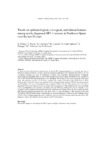Mostrar o rexistro simple do ítem
Trends on epidemiological, virological, and clinical features among newly diagnosed HIV-1 persons in Northwest Spain over the last 10 years
| dc.contributor.author | Pernas, Berta | |
| dc.contributor.author | Mena, Álvaro | |
| dc.contributor.author | Cañizares, Angelina | |
| dc.contributor.author | Grandal, Marta | |
| dc.contributor.author | Castro-Iglesias, Ángeles | |
| dc.contributor.author | Pértega-Díaz, Sonia | |
| dc.contributor.author | Pedreira, José D. | |
| dc.contributor.author | Poveda, Eva | |
| dc.date.accessioned | 2017-04-19T11:10:55Z | |
| dc.date.available | 2017-04-19T11:10:55Z | |
| dc.date.issued | 2015-03-16 | |
| dc.identifier.citation | Pernas B, Mena A, Cañizares A, et al. Trends on epidemiological, virological, and clinical features among newly diagnosed HIV-1 persons in Northwest Spain over the last 10 years. J Med Virol. 2015;87(8):1319-1326 | es_ES |
| dc.identifier.issn | 0146-6615 | |
| dc.identifier.issn | 1096-9071 | |
| dc.identifier.uri | http://hdl.handle.net/2183/18403 | |
| dc.description.abstract | [Abstract] To describe temporal trend and characteristics of newly HIV-diagnosed patients in a medical care area in Northwest Spain over the last 10 years. All newly diagnosed patients for HIV-infection from 2004 to 2013 at a reference medical care area in Northwest of Spain were identified. Epidemiological, virological, immunological, and clinical data, as well as HIV genotype and drug resistance information were recorded. A total of 565 newly HIV-diagnosed patients were identified. The number of new cases increased in the last 5 years (66 cases/year). Overall, 53.1% had a median CD4 counts < 350 cells/µl and 33.6% had an AIDS defining criteria. Non-B variants were found in 34.4% of patients being subtype F (25.8%) the most common non-B subtype. The rate of transmitted drug resistance (TDR) over the study period was 3.7%, but a decreased to 2.6% was observed in the last 5 years. The most prevalent TDR mutations were: T215 revertants (1.5%), K219QENR (1.2%), for NRTIs; K103N (1.9%), for NNRTIs; L90M (0.3%), for PIs. Overall, 73.2% of patients started antiretroviral treatment and 9.9% of patients died during follow-up. The number of newly HIV diagnosed patients increased since year 2009. There is a high prevalence of late diagnosis (53%) and 33% had an AIDS defining criteria. Interestingly, the most prevalent non-B subtype in our population was F (25.8%). These findings support the need to facilitate the access for HIV testing to reduce the rate of late HIV diagnosis, improve the clinical outcome and prevent HIV transmission. | es_ES |
| dc.description.sponsorship | Instituto de Salud Carlos III; CP08/00214 | es_ES |
| dc.description.sponsorship | Instituto de Salud Carlos III; PI10/02166 | es_ES |
| dc.description.sponsorship | Instituto de Salud Carlos III; CM13/00328 | es_ES |
| dc.description.sponsorship | Instituto de Salud Carlos III; PI13/02266 | es_ES |
| dc.language.iso | spa | es_ES |
| dc.publisher | Wiley | es_ES |
| dc.relation.uri | http://dx.doi.org/10.1002/jmv.24185 | es_ES |
| dc.rights | This is the peer reviewed version of the article which has been published in final form at Wiley Online Library. This article may be used for non-commercial purposes in accordance with Wiley Terms and Conditions for self-archiving | es_ES |
| dc.subject | Newly HIV-diagnoses | es_ES |
| dc.subject | Late diagnosis | es_ES |
| dc.subject | HIV-1 genetic subtype | es_ES |
| dc.subject | Transmitted drug resistance | es_ES |
| dc.title | Trends on epidemiological, virological, and clinical features among newly diagnosed HIV-1 persons in Northwest Spain over the last 10 years | es_ES |
| dc.type | info:eu-repo/semantics/article | es_ES |
| dc.rights.access | info:eu-repo/semantics/openAccess | es_ES |
| UDC.journalTitle | Journal of Medical Virology | es_ES |
| UDC.volume | 87 | es_ES |
| UDC.issue | 8 | es_ES |
| UDC.startPage | 1319 | es_ES |
| UDC.endPage | 1326 | es_ES |
Ficheiros no ítem
Este ítem aparece na(s) seguinte(s) colección(s)
-
INIBIC-VC - Artigos [37]
-
INIBIC-ECB - Artigos [50]






